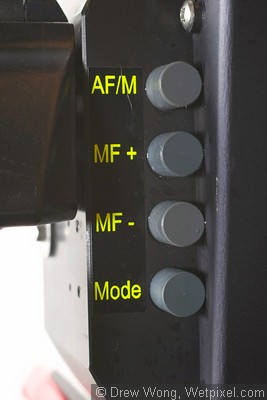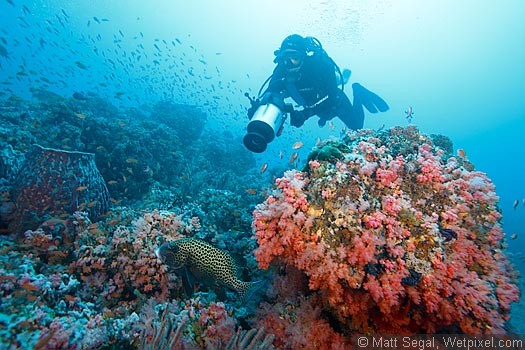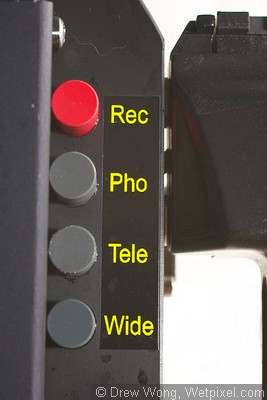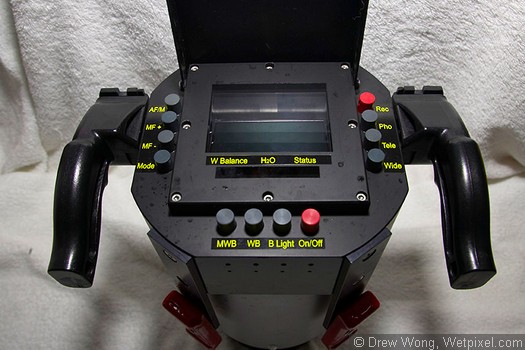Mangrove MVD L-2 for Sony HDR-HC1 and HVR-A1 review
The Field Test
I had plenty of issues with equipment during the test. My light batteries (both systems) died so I had no lighting setup to test for night dives. My first dive with the housing was a bit of a disaster in that I was out of battery after the first 2 minutes. I thought the FM50 had died as I had recharged the battery the night before when I set up the housing for the next day. Then it happened again on the next day on the first dive. Then I realized when you turn off the camera using the LANC control with this system, the camera was still drawing power somehow. (when you turn the camera OFF using the ON-OFF pushbutton the LANC electronics does not consume any energy at all, what really consumes some energy is the camcorder itself, some models more than others, for example the new Sony EX1 can deplete the battery overnight, another possible explanation is that your batteries have a very high self discharge rate or your battery charger is not working properly). That’s why it always quit the next day due to low battery. At least this was what was happening with my unit. I tried it with two different batteries with the same result. Obviously this is an important note to remember when setting up the housing before a dive…CHECK THE BATTERIES ONLY JUST BEFORE THE DIVE! (I always prepare the housing the night before and leave it in OFF using the ON/OFF housing pushbutton, and I have never had the problem you had neither any of the customer that use our housing) * In fairness, I do think the HVR-A1P has different LANC protocols. Aditech has not tested the housing for the A1P but the HC1. Both cameras are 3 years old so I doubt it’s a concern for Aditech.
One of the most important features of this housing was the Electronic Manual White Balance (EMWB). It works through a firmware hack where it tricks the camera into doing a full WB recycle. The process is not the same as using the MWB that is on camera (which is usually a quick 0.5-1 second). This hack needs at least 3-4 seconds to work. Still it gives users control of what some consider to be a crucial function. Unfortunately, it didn’t work as promised with the HVR-A1. I tried it topside as well and it also failed to cycle into the proper white balance, reverting to whatever WB was there before after 4 seconds of cycling through the WB modes. The on-camera WB was working perfectly. I’ve been told that the Mangrove housing EMWB works with the later HC7/9 series cameras but I cannot corroborate this personally.

The bottom control panel with EMWB, WB mode toggle, lights (optional) and on/off switch
With the big money draw EMWB function unavailable, I concentrated on the handling and ergonomics of the little housing. With the camera battery, monitor and batteries all at the rear, even with the lighter delrin construction, the housing was rear heavy even with the near neutral WP80 attached. Adjusting the balance weights forward, I was able to move the center of gravity more noseward. With the axis of rotation moved forward slightly, the housing settled to a nice slight positively buoyant stance. I added two dovetail clamps (standard Sea & Sea) and a 6” ULCS arm with a clamp to balance the housing further and get it to a slight negative.
The handling was surprisingly good. Initially, I thought I’d have problems with the handles being that far back from the center of the housing. With the counter balance arm I created with the ULCS fitment and the housings adjustable bottom weights, the housing was quite easy to handle and was actually stable for a tube design housing without ‘wings’ (Aditech is planning stabilizer wings as an accessory). I had good pitch and yaw control and slow steady panning wasn’t difficult either. This was without any light heads and add-ons. With lights, batteries and arms (even locline), I’m sure the balance would have to be readjusted again. Aditech states the housing was balance was designed with their video lights system in mind.

The left control panel with focus and mode controls
The rearward placement of the handles is also a boon for those who suffer from Hyperopia and Presbyopia. Rear monitor housings can be difficult for bad eyesight sufferers and often I see many people shoot with arms straight out to be able to focus. A few inches does make a difference for many and the handle position allows all but the most farsighted divers to comfortably maintain relaxed arms for steady shooting.

Handling and balance was good, as was the clarity of the LCD at depth
The monitor was easy to see and bright when viewing over 60° incident angle to the sun. The monitor shade is made of metal and doubles as a protector for the monitor when you rest the housing on the monitor back. Focus could be judged quite well due to the sharpness of the monitor. However in shallow water looking down on sunny days, the reflections make it difficult to see as it is on most other monitor back housings. The monitor shade isn’t long enough nor did it block light coming from the sides to be helpful in that situation. ( I don´t know if you realized that the monitor was 25º angled, it means that the upper part of the LCD screen is at 3cm from the window surface, then you have the additional shade, the other manufactures that install a monitor back don´t put it so deep into the housing body like us)

The right control panel with ZOOM in/out, PHOTO and REC controls
The ergonomics of the housing was tidy. The left and right row of buttons were within easy reach of my thumb without having to release the handle. Only the bottom center two buttons required enough movement to cause camera shake when I tried to use them without letting go for the handles. The pressure needed to actuate the buttons was not too demanding, minimizing any camera shake from having to push hard to actuate the buttons. The REC and ON/OFF buttons are colored red and the others white. The screen shows the typical Sony menu data sans guidelines, zebra and peaking.

The rear bulkhead with controls and LCD monitor back
(the monitor shade can be easily flipped up/down)
So it handles well and the controls are easy to use but what about the lens performance? The lens I tested was the WP80 Fathoms designed lens. This lens is an optional add-on to the housing. The resolution chart showed a drop in resolution (common with WA adapters) but nothing that would affect the picture too much. The 80° (depending on the camera and distance from the camera it can vary by as much as 10°) was even and didn’t suffer from flaring. At it’s widest, it had a teeny bit of barrel distortion but you had to look for it. It’s a partial zoom lens (more on that in the conclusion).
After the dives, opening the housing required I use that little lever to use as a fulcrum to push open the front bulkhead. This requires a certain discipline I’m not accustomed to so sometimes I just used my hands twist it open after releasing the latches. It’s not elegant and you can damage the camera if you’re not careful so I wouldn’t use this method.